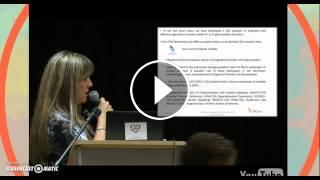272
צפיות
- קטגוריה
- רפואה ובריאות אינדקס מחלות
סרטונים נוספים
-
Acharya K Nuskhe: Arjuna Herb Helps In Treating Mouth And Ear Infections דלקות...
מאת vod-galit 350 צפיות -
Infections Of The Oral Cavity דלקות פה-לוע-שקדים
מאת vod-galit 297 צפיות -
Mouth And Throat Infections דלקות פה, לוע, שקדים
מאת vod-galit 426 צפיות -
PID Testimonial - Mother Of An Agammaglobulinemia Patient א-גאמא-גלובולינמיה
מאת vod-galit 310 צפיות -
MFYH What Is Viral Myocarditis? דלקת שריר הלב
מאת vod-galit 288 צפיות -
היפוגליקמיה - היפו, נפילת סוכר איך מתמודדית עם זה
מאת vod-galit 278 צפיות -
Infections In Autoimmune Disease; Are Gut Infections Causing Autoimmune Hepatitis? דלקת...
מאת vod-galit 277 צפיות -
דלקת מפרקים שגרונית
מאת admin 395 צפיות -
Agammaglobulinemia Explanation | א-גאמא-גלובולינמיה
מאת vod-galit 287 צפיות -
Viral Hepatitis (A, B, C, D, E) - Causes, Symptoms, Diagnosis, Treatment & Pathology הפטיטיס
מאת vod-galit 321 צפיות -
Pneumonia - Is It Viral Or Bacterial ? דלקת ריאות מחיידקים
מאת vod-galit 304 צפיות -
What Are The Different Types Of Ear Infections
מאת vod-galit 314 צפיות -
עיצוב צמות לילדות
מאת vod-galit 2,846 צפיות -
סודות בתאריך הלידה, משמעות חודש הלידה - ינואר זינה ליבשיץ נומרולוגית
מאת vod-galit 1,835 צפיות -
רנה רז-גילו - נומרולוגית - ייעוץ אישי און-ליין- נומרולוגית בגבעת שמואל
מאת Shahar-vod 434 צפיות -
יוסי שר - מתמחה בשיטת אלכסנדר וטאי צ'י ברחובות ובקיבוץ נען
מאת Shahar-vod 761 צפיות -
איך לטפל בכבד שומני וטריגליצרידים גבוהים בדם
מאת vod-galit 917 צפיות -
מירב מתן - רפואת תדרים וביו אנרגיה באלעד - האם באמת הכל בראש שלנו?
מאת Shahar-vod 309 צפיות -
תסרוקות לבית ספר-מגוון שיטות לקליעת צמות לילדות HAIR STYLING
מאת vod-galit 35.8k צפיות -
לנה שסטקוב - טיפול בכאבי גב בירושלים - כלים לחיים בריאים, איזון וריפוי גוף נפש
מאת Shahar-vod 508 צפיות -
אורלי שטיינבך - פסיכותרפיה גופנית ודמיון מודרך בתל אביב- כלים של תמיכה ומגע עצמי לשחרור מתחים - 2
מאת Shahar-vod 555 צפיות -
אורלי שטיינבך - פסיכותרפיה גופנית ודמיון מודרך בתל אביב- תרגילי הרפיה להפחתת מתחים - וידיאו 3
מאת Shahar-vod 308 צפיות -
מירב מתן - רפואת תדרים וביו אנרגיה באלעד - חרדה (1)
מאת Shahar-vod 380 צפיות -
מירב מתן - רפואת תדרים וביו אנרגיה באלעד - איך נראה אומץ?
מאת Shahar-vod 327 צפיות















 תפריט נגישות
תפריט נגישות







